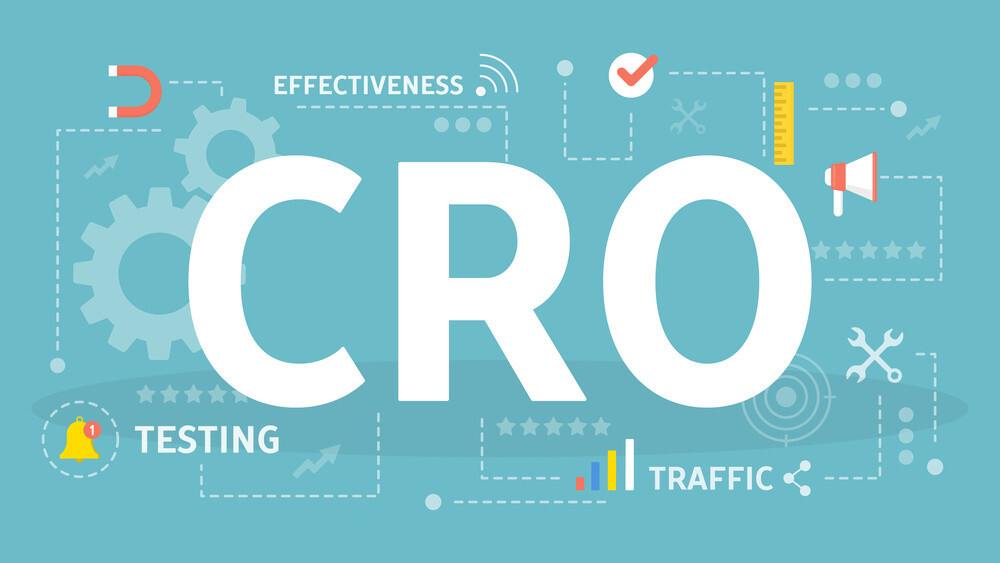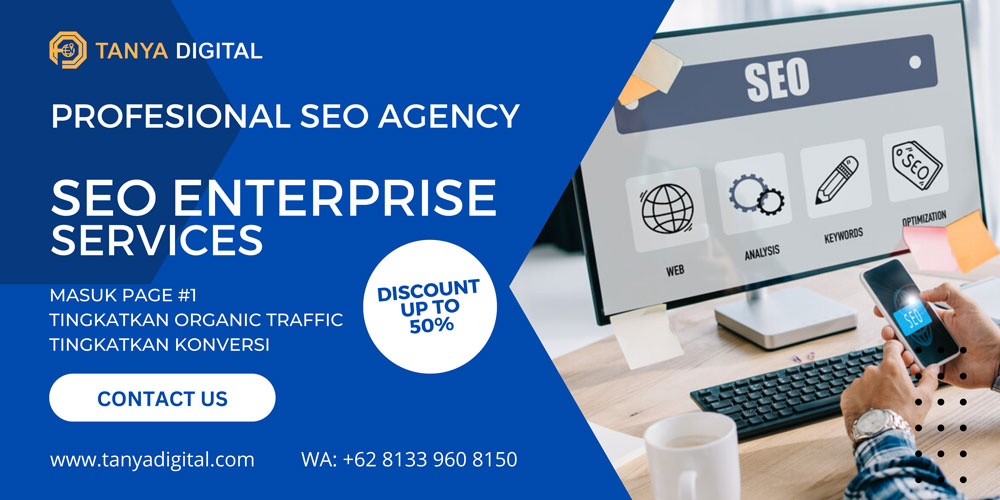Conversion Rate Optimization (CRO) is a systematic process to increase the percentage of website visitors who take the desired action whether it is filling out a form, becoming a customer, or otherwise.
The CRO process involves understanding how users move through your website, what actions they take, and what is stopping them from completing your goals.

What is a Conversion Rate (CRO)?
Conversion is a general term for visitors who complete a goal on a website. Goals can come in all shapes and sizes. If you are using a website to sell products, the main goal (known as macro conversion) is for your website users to make a purchase. There are smaller conversions that can occur before the user has completed the macro conversion, such as signing up to receive an email. This is called micro conversion.
Contoh – contoh konversi
Macro conversion:
Buy products from the website
Ask for a quote
Subscribe to a service
Micro conversion example:
Register by email
Create an account
Add products to cart
What is the conversion rate?
Website conversion rate is the number of times users complete a goal divided by website traffic. If a user can convert with each visit (such as by purchasing a product), divide the number of conversions by the number of sessions (the number of unique times users came to your website). If you’re selling subscriptions, divide the number of conversions by the number of users.
Conversion rate optimization occurs after a successful visit reaches your website. This is different from conversion optimization for SEO or paid advertising which focuses on who clicks on your website from organic search results, how many clicks you get, and which keywords drive traffic.
ALSO READ : What is Lead Generation? Importance and Purpose in Digital Marketing
How to Calculate the Conversion Rate
If users can convert every time they visit the website:
Imagine that we have an e-commerce website. A user can make a new purchase every session. Of course we want to optimize so that they make as many purchases as possible. If a user visits the website three times, it will be three sessions and three chances to convert.
Let’s take a closer look at our three user sessions and how they behave:
Session 1: No conversions – users familiarize themselves with your website and have a look.
Session 2: The user buys a shiny new cellphone.
Sesi 3: Pengguna kembali dan membeli aksesoris hp dan baterai. konversi lagi! Meskipun mereka membeli dua item, ini adalah satu pesanan unik dan dengan demikian dihitung sebagai satu konversi.
To find out the conversion rate, let’s take the number of unique purchase orders and divide it by the total number of sessions.
Calculating Conversion Rate by Session:
If the user can only convert once
Now imagine that we have a second website which is a website that sells subscriptions for monthly delivery of motorbike parts. A user may come back multiple times, but once they buy a subscription, they won’t convert again.
[amp-cta id=’73465′]

Let’s look at an example of user behavior:
Session 1: The user opens the site for the first time to explore the service. No conversion.
Session 2: Users subscribe to the monthly GearBox service. this is our conversion!
Session 3: Users return to read blog articles and have a look.
Users here can’t convert every time they visit the site. So instead of looking at the number of sessions, we need to measure conversion success based on the number of visitors:
To find out the website conversion rate, let’s take the number of unique orders and divide it by the number of unique users.
Calculating Conversion Rate by Unique Users:
5 Ways CRO is profitable for SEO
While not necessarily directly related to attracting organic website traffic or ranking on the search engine results page (SERP), conversion rate optimization has distinct benefits and advantages for SEO.
Here are 5 Benefits of Conversion Rate Optimization for SEO
Improved customer insight: Conversion rate optimization that can help you better understand your main audience and find out what language or message best suits their needs can be a benefit of conversion rate optimization. Conversion rate optimization is seen from how to find the right customers for your business. Getting more people or users is of no use to your business if they are not the right kind of person!
Better ROI: A higher conversion rate means the more resources you have available which can benefit conversion rate optimization. By learning how to get the most from your acquisition efforts, you’ll get more conversions without having to bring in more potential customers.
Better scalability: Although your audience size may not scale as your business grows, CRO allows you to grow without running out of resources and potential customers which can benefit from conversion rate optimization and conversion rate optimization benefits. Unlimited audience. By converting more visitors into buyers, you can grow your business without losing potential customers.
Better user experience: When users feel smart and understanding on your website, they tend to stick around. CRO learns what works on your website. By taking what works and building on it, you will create a better user experience. Users who feel empowered by your website will feel more directly involved and some may even be good news providers for your brand.
Enhanced trustworthiness: In order for users to share credit card, email, or any personal information, they must truly trust the website. Your website is the number one salesperson for you. Just like an in-house or offline sales team, your website must look professional, courteous, and ready to answer all your customers’ questions.
ALSO READ: How to Testing Facebook Ads and Getting Optimal Results
The key to success to Increase Conversion Rate
To optimize conversion rates, you have to know where, what to optimize, and for whom it is optimized. This information is the foundation for a successful CRO strategy.
If you don’t collect data, then you make changes based on feeling. But making decisions based solely on instinct rather than rooting in assumptions in data can be a waste of time and money.
Analytical methods
This method, also known as quantitative data analysis, can give you the exact numbers behind the behavior of the people who are on your website. Start with a solid web analytics platform, such as Google Analytics. Next, add tracking for conversions.
Using an analytics-based CRO can answer important questions about how users engage with your site. Quantitative analysis provides information such as:
- Where people enter your website, which is which web page they open first
- Which features do they use, that is, where on the page or on the website they spend their time
- What channels and referrals bring them, which is where they find and click on the link to your website.
- What devices and browsers do they use
- Who are your customers (age, demographics and interests)
- Where the user leaves your conversion funnel, i.e. where or during what activity the user leaves your website.
This information will tell you where to focus your efforts. By putting the effort into the pages that are most engaging and valuable to the user, And in the end you’ll see the biggest impact.
Method of people
Doing quantitative analysis first is invaluable if you have a large website with mixed content because it tells you, from a numerical perspective, where to focus your efforts. Now that you know how users interact with your website, you can see the “why” behind their behavior.
This person-focused method, known as qualitative data analysis, is more subjective. You will also need the quantitative data discussed above to identify who to ask. You can’t optimize for all users, so optimize for your ideal user that is, the most important user to have as a customer.
How to get this data:
- On-site survey
- User testing
- Satisfaction survey
Qualitative analysis helps optimize conversions by providing information about users such as:
- Why are they involved? Why did they initially decide to visit your website or open a certain page? What about the page or product they are interested in?
- According to them, what does your website offer that makes you different from competitors? Are there features or services offered by your company that make your buying experience better?
- What words do they use to describe the products, services and problems they face? How do they describe your product or service to friends? In essence, how do they talk about what you did?
There are some things that raw data can’t tell you about what brings users to your website or how to make their experience better. When you combine this information with analytical data, you will gain a much better understanding of the pages on your website that present the best opportunities to optimize and engage the audience you want to target.
Bad method
Some of the less effective CRO methods include:
- Guesses, hunches and hunches
- Do it because your competition is doing it
- Implement changes based on the opinions of the highest paid people
All of these examples have something in common: they are not data-driven and may also be obscure random shots. It’s better to spend time collecting and analyzing data so you can make meaningful tests based on clear insights. Nobody likes running a failed test.






